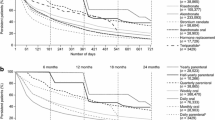Abstract
Introduction
Patient compliance with osteoporosis drug therapy is often poor in clinical practice and may be associated with higher risk of fracture.
Methods
A nested case-control study was undertaken using a US health insurance claims database. The source population included all women aged ≥45 years who began drug therapy for osteoporosis. Cases consisted of those who experienced an osteoporosis-related fracture; they were matched to controls without osteoporosis-related fracture. Compliance with osteoporosis drug treatment was assessed in terms of the number of therapy-days received and medication possession ratio (MPR). Conditional logistic regression was employed to examine the relationship between compliance and fracture risk.
Results
A total of 453 women with osteoporosis-related fracture were identified and matched to 2,160 controls. Fracture risk was significantly lower for patients with >180 days of therapy [181–360 days: odds ratio (OR) = 0.70, 95% CI = 0.49–0.99; >360 days: OR = 0.65, 95% CI = 0.43–0.99) versus those with ≤30 days. Risk was also lower for patients with MPR ≥90% (OR = 0.70, 95% CI = 0.52–0.93) versus those with MPR <30%. Fracture risk decreased as compliance increased (ptrend < 0.05).
Conclusion
Among women initiating drug therapy for osteoporosis, better compliance is associated with reduced risk of fracture.
Similar content being viewed by others
References
U.S. Department of Health and Human Services. Bone health and osteoporosis: A report of the Surgeon General. Rockville, MD, U.S. Department of Health and Human Services, Office of the Surgeon General; 2004
Andrade SE, Sumit RM, Chan KA et al (2003) Low frequency of treatment of osteoporosis among postmenopausal women following a fracture. Arch Intern Med 163:2052–2057
Melton LJ III, Thamer R, Ray NF et al (1997) Fractures attributable to osteoporosis: Report from the National Osteoporosis Foundation. J Bone Miner Res 12:16–23
Eichner SF, Lloyd KB, Timpe EM (2003) Comparing therapies for postmenopausal osteoporosis prevention and treatment. Ann Pharmacother 37:744–746
Feldstein AC, Nichols GA, Elmer PJ et al (2003) Older women with fractures: Patients falling through the cracks of guideline-recommended osteoporosis screening and treatment. J Bone Joint Surg 85A:2294–2302
Cuddihy MT, Gabriel SE, Crowson CS et al (2002) Osteoporosis intervention following distal forearm fractures: A missed opportunity? Arch Intern Med 162:421–426
Freedman KB, Kaplan FS, Bilker WB et al (2000) Treatment of osteoporosis: Are physicians missing an opportunity? J Bone Joint Surg 82–A(8):1063–1070
Recker RR, Gallagher R, MacCosbe PE (2005) Effect of dosing frequency on bisphosphonate medication adherence in a large longitudinal cohort of women. Mayo Clin Proc 80:856–861
Kayser J, Ettinger B, Pressman A (2001) Postmenopausal hormonal support: Discontinuation of raloxifene versus estrogen. Menopause 8:328–332
Ettinger B, Pressman A, Schein J et al (1998) Alendronate use among 812 women: Prevalence of gastrointestinal complaints, noncompliance with patient instructions, and discontinuation. J Managed Care Pharm 4:488–492
Caro JJ, Ishak KJ, Huybrechts KF et al (2004) The impact of compliance with osteoporosis therapy on fracture rates in actual practice. Osteoporos Int 15:1003–1008
McCombs JS, Thiebaud P, McLaughlin-Miley C et al (2004) Compliance with drug therapies for the treatment and prevention of osteoporosis. Maturitas 48:271–287
Siris ES, Rosen CJ, Harris ST, Abbott TA, Barr CE, Silverman SL. Adherence to bisphosphonate therapy: relationship to bone fractures at 24 months in women with postmenopausal osteoporosis. Presented at the National Osteoporosis Foundation 6th International Symposium. http://nof.confex.com/nof/2005/techprogram/P397.HTM. Accessed July 21, 2006
Huybrechts KF, Ishak KJ, Caro J (2006) Assessment of compliance with osteoporosis treatment and its consequences in a managed care population. Bone 38:922–928
Health Insurance Portability and Accountability Act of 1996, 42 USC §1320–d2
Public Welfare-Protection of Human Subjects; 45CFR 46 §46.101
Black DM, Thompson DE, Bauer DC et al (2000) Fracture risk reduction with alendronate in women with osteoporosis: the fracture intervention trial. J Clin Endocrinol Metab 85:4118–4124
Cummings SR, Black DM, Thompson DE et al (1998) Effect of alendronate on risk of fracture in women with low bone density but without vertebral fractures: Results from the fracture intervention trial. JAMA 280:2077–2082
Ettinger B, Black DM, Mitlak BH et al (1999) Reduction of vertebral fracture risk in postmenopausal women with osteoporosis treated with raloxifene: Results from a 3-year randomized clinical trail. JAMA 282:637–645
Liberman UA, Weiss SR, Broll J et al (1995) Effect of oral alendronate on bone mineral density and the incidence of fractures in postmenopausal osteoporosis. N Engl J Med 333:1437–1443
McClung MR, Geusens P, Miller PD et al (2001) Effect of risedronate on the risk of hip fracture in elderly women. N Engl J Med 344:333–340
Osterberg L, Blaschke T (2005) Drug therapy: Adherence to medication. N Engl J Med 353:487–497
Sikka R, Xia F, Aubert RE (2005) Estimating medication persistency using administrative claims data. Am J Manag Care 11:449–457
Acknowledgements
Funding for this research was provided by Amgen, Inc., Thousand Oaks, California. The authors thank Manjusha Gokhale of Policy Analysis Inc. (PAI) for her assistance with data management and Enkhe Badamgarav, M.D., M.P.H., of Amgen Inc. for her invaluable comments on the manuscript.
Author information
Authors and Affiliations
Corresponding author
Additional information
Financial Support: Funding for this research was provided by Amgen, Inc., Thousand Oaks, California.
Appendix
Appendix
Rights and permissions
About this article
Cite this article
Weycker, D., Macarios, D., Edelsberg, J. et al. Compliance with osteoporosis drug therapy and risk of fracture. Osteoporos Int 18, 271–277 (2007). https://doi.org/10.1007/s00198-006-0230-y
Received:
Accepted:
Published:
Issue Date:
DOI: https://doi.org/10.1007/s00198-006-0230-y




